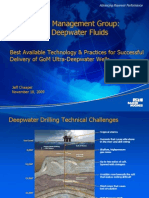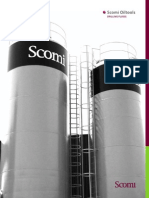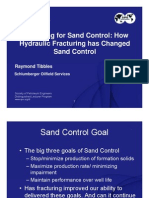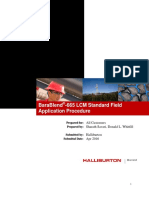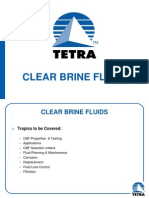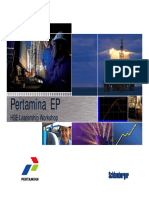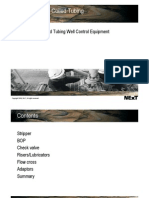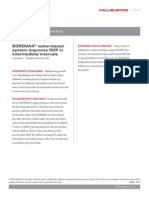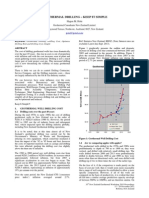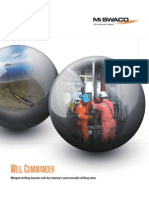10 - Drilling Fluids Design and Selection - Handout
10 - Drilling Fluids Design and Selection - Handout
Uploaded by
Fauzan Rahman HaqCopyright:
Available Formats
10 - Drilling Fluids Design and Selection - Handout
10 - Drilling Fluids Design and Selection - Handout
Uploaded by
Fauzan Rahman HaqOriginal Description:
Original Title
Copyright
Available Formats
Share this document
Did you find this document useful?
Is this content inappropriate?
Copyright:
Available Formats
10 - Drilling Fluids Design and Selection - Handout
10 - Drilling Fluids Design and Selection - Handout
Uploaded by
Fauzan Rahman HaqCopyright:
Available Formats
5/21/2010
Global Research & Technology Centre/ GRTC Training Department
Drilling Fluids: Design & Selection
SCOMI OILTOOLS
Key elements of a successful Drilling Fluid Operation
HS&E Tender Drilling Fluid Design & Selection
Rig & Mud Plant Specs
Successful Drilling Fluid Process
Personnel
Drilling Fluid Design & Selection
Quality Control Solids Control
Technical Service
SCOMI OILTOOLS
5/21/2010
There are only two reasons why we drill a hole in the ground:
To collect geological and reservoir data
To successfully exploit and produce oil & gas
SCOMI OILTOOLS
Primary operational goals
Deliver quality geological and reservoir data Minimise reservoir damage to optimise oil & gas recovery
Secondary operational goals
Achieve technical limit drilling performance
Note: The considerable reduction in operational costs as a consequence of technical limit drilling performance is valid only to the degree that the primary operational goals are successfully met! Appropriate drilling fluid design and selection is a prerequisite in order to fully meet both our primary and secondary goals
SCOMI OILTOOLS
5/21/2010
Primary factors that impact drilling fluid design & selection
SCOMI OILTOOLS
Primary functions of a drilling fluid
Minimise fluid invasion into formations Maintain a stable in gauge well bore Minimise shale hydration & dispersion Efficiently transport cuttings to surface Minimise reservoir damage
Prevent the flow of oil and gas while drilling Lubricate the drill string Lubricate & cool the drill bit Transmit Hydraulic Horsepower (HHP) to the bit
Maximise Rate or Penetration (ROP)
SCOMI OILTOOLS
5/21/2010
Drilling fluid design & selection considerations
Do you want to be first to try something new? Risk management Formation damage Lubrication Waste disposal options Local regulations Shale inhibition Completion design Who has the fluids contract? What has worked before? Who needs to be involved? Temperature and pressure
SCOMI OILTOOLS
Are mud losses expected?
Cost of Fluid
Mud weight
Company policy
Primary drilling fluid design and selection GOALS
To fully meet all regulatory and internal HSE guidelines and goals. To provide a stable wellbore to facilitate the successful running / retrieval of quality geological and reservoir data. To minimise reservoir damage and thereby optimise well productivity and profitability. To optimise drilling performance and thereby reduce overall drilling
SCOMI OILTOOLS
5/21/2010
Framework for drilling fluid design, testing & selection
Test, evaluate and select drilling fluid systems that will fully meet all regulatory and internal HSE guidelines.
This is especially applicable to synthetic oil based muds.
Test & analyse the physical & electro-chemical characteristics of the clays, shales, mudstones and reservoir sequences to be drilled. Design & test for the best synergy between the clays, shales or mudstones with various water based mud system options in order to minimise hydration & control dispersion.
SCOMI OILTOOLS
Framework for drilling fluid design, testing & selection
Test various water based and / or synthetic oil based mud formulations for their tolerance to: Drill solids Barite weight up Applicable drilling fluid contaminants including cement Temperature stability at anticipated BHT On the basis of the test results evaluate, optimise and then select the appropriate water based or synthetic oil based mud system to meet your well specific drilling and reservoir challenges.
SCOMI OILTOOLS
5/21/2010
Thoroughly review the following key elements
Environmental regulations & guidelines. Offset well data, ie well programs / well summaries and drilling fluid specific programs / summaries. Reservoir data: offset reverse permeability test data mercury injection data for reservoir pore throat size range prognosed in-situ shales or shale beds present in reservoir sands anticipated pore pressure gradient and temperature gradient in the reservoir
SCOMI OILTOOLS
Thoroughly review the following key elements
Logging plan, ie duration & prognosed maximum bottom hole temperature. Testing plan, ie special fluid and kill pill requirements. Development well - completion plan, ie perforated liner, expandable or fixed screens, sliding sleeve, etc. Well clean up and fluid design program to be based on completion design criteria.
SCOMI OILTOOLS
5/21/2010
Thoroughly review the following key elements
Potential for the presence of acid gasses, CO2 & H2S. Prognosed fractured and / or faulted zones with the potential for lost circulation Maximum prognosed temperature for each hole section.
SCOMI OILTOOLS
Thoroughly review the following key elements
Deep water wells: Seabed depth Seabed temperature In-situ gas hydrates potential for formation of gas hydrates Drilling fluid lubricity: A key element in terms of potential torque & drag limitations when planning to drill a long reach step out well. Note: Lubricity is also a significant factor when drilling deviated wells through hard rock, eg granite.
SCOMI OILTOOLS
5/21/2010
Thoroughly review the following key elements
Exploration well, ie wildcat or mature exploration area. Detailed lithology profile. Casing design options. Hole sizes / depths MD & TVD as applicable. Directional plan inclination & azimuth. Wellbore stress modeling data, ie in-situ vertical stress & minimum / maximum horizontal stress prediction.
SCOMI OILTOOLS
Thoroughly review the following key elements
Pore pressure prediction, ie mud weight range for each hole section. Data sources used to predict pore pressure gradient: Sonic / resistivity logs, seismic data analysis, micro hydraulic fracturing (MDT), drilling records and bore hole modeling. Offset well leak off & F.I.T. test data. Mud plant capacities / warehouse facilities, product availability and lead times. Rig specifications / limitations, ie tank capacities, solids control equipment and rig mixing / delivery systems.
SCOMI OILTOOLS
5/21/2010
Risk management in drilling fluid design & selection
SCOMI OILTOOLS
Risk management in drilling fluid design & selection
Management of risk
Lower
O P TI M U M D RI LL IN G P E R F O R M A N C E
Overall well costs
Risk
Choice of drilling fluid systems: Synthetic oil based mud Enhanced KCL / Polymer / Glycol & Surfactants KCL / Polymer / Glycols Silicates Dispersed muds
Higher Higher
C R IT I C A L F A IL U R E LI N E
Lower
Poor shale inhibition Hole stability problems Stuck pipe Low ROPs Consequences of poor drilling practices
I N C R E A S E D H & S R I S K S
Exception: Dispersed muds are often the most economical low risk option for drilling shallow, young, weakly consolidated shales
Brine systems Fully dispersed fresh water / lignosulfonate / Lime / gyp muds Bentonite muds / spud muds SW / viscous sweeps
Failure to run & retrieve quality logging data Reservoir damage, etc
Higher
Inhibitive properties
Lower
Evaluate risk ie potential value of success vs the potential cost of failure
SCOMI OILTOOLS
5/21/2010
Risk management in drilling fluid design & selection
Management of risk
C R I T I C A L F A I L U R E L I N E
160 140 120 100
Example lost time analysis for an offshore well
80 60 40 20 0
I N C R E A S E D H & S R I S K S
Hours
The cost of failure !
SCOMI OILTOOLS
Advantages & disadvantages of SBM & WBM
SCOMI OILTOOLS
10
5/21/2010
Advantages & disadvantages of SBM & WBM
SCOMI OILTOOLS
Advantages & disadvantages of SBM & WBM
WBM
Environmental
Moderate environmental impact. Dependant upon type of WBM system.
SBM
Environmental
Moderate to significant environmental impact, however this impact can be managed, e.g. cuttings re-injection, ship to shore, etc.
Hole stability & hole gauge
Open hole stability sustainable for long periods of time. Close to gauge well bore.
Hole stability & hole gauge
Open hole stability very time dependent. From close to gauge to out of gauge well bore dependent upon appropriate water based mud system design & selection requirements.
Accretion / bit balling
Minimal to zero accretion / bit balling.
Accretion / bit balling
Severe to minimal accretion/ bit balling problems. Dependant upon appropriate water based mud system design & selection.
SCOMI OILTOOLS
11
5/21/2010
Advantages & disadvantages of SBM & WBM
SBM
ROPs
Higher ROPs in most drilling environments.
WBM
ROPs
Lower Rops in most drilling environments.
Torque & drag
Lower torque & drag values.
Torque & drag
Higher torque & drag values.
Temperature stability
High thermal stability 450F +
Temperature stability
Lower thermal stability, ie above 280 F require special H.T. products for thermal stability to +/400 F. Potential problems maintaining stable mud properties at very high temperatures.
SCOMI OILTOOLS
Advantages & disadvantages of SBM & WBM
SBM
ROPs
Higher ROPs in most drilling environments.
WBM
ROPs
Lower Rops in most drilling environments.
Torque & drag
Lower torque & drag values.
Torque & drag
Higher torque & drag values.
Temperature stability
High thermal stability 450F +
Temperature stability
Lower thermal stability, ie above 280 F require special H.T. products for thermal stability to +/400 F. Potential problems maintaining stable mud properties at very high temperatures.
SCOMI OILTOOLS
12
5/21/2010
Advantages & disadvantages of SBM & WBM
SBM
Lubricity
Lower coefficient of friction = good lubricity
0.45 0.4
WBM
Lubricity
Higher coefficient of friction = poor lubricity
Coefficient of Friction
0.35 0.3 0.25 0.2 0.15 0.1 0.05 0
SBM SBM
WBM with lubricant WBM + lubricant
SCOMI OILTOOLS
Metal to sandstone
Metal to shale
Advantages & disadvantages of SBM & WBM
SBM
Risk of unscheduled events
Low risk of costly unscheduled events, e.g. hole stability problems, stuck pipe, etc. Subject to good drilling practices due to close to gauge hole.
WBM
Risk of unscheduled events
Much higher risk of costly unscheduled events, e.g. hole stability problems, stuck pipe, etc.
Long reach step out wells
Extended long reach step out range (distance) due to the lower co-efficient of friction ie lubricity significantly reduces torque & drag values.
Long reach step out wells
Diminished long reach step out range (distance) due to the higher co-efficient of friction ie higher torque & drag values and potential hole stability problems related to time!
Stuck pipe
Generally easier to recover from mechanically stuck pipe and twist off type incidents, i.e lubricious, stable & close to gauge well bore conducive to more successful jarring/ fishing operations.
Stuck pipe
Generally more difficult to recover from mechanically stuck pipe and twist off type incidents, i.e less lubricious, hole stability time dependant and possibility of out of gauge well bore results in a more challenging jarring/ fishing environment.
SCOMI OILTOOLS
13
5/21/2010
Advantages & disadvantages of SBM & WBM
SBM
Hole stability (time)
Extended time period before the onset of hole instability problems. Especially significant when unscheduled events are encountered, eg pipe twist off, rig shut down for cyclones, etc.
WBM
Hole stability (time)
Limited time period before onset of open hole stability problems. High risk of unscheduled events resulting in stuck pipe and probable requirement to side track.
Fluid loss
Low invasion rates ( fluid loss properties) moderate the rate at which the rock matrix weakens followed by hole stability problems.
Fluid loss
Higher invasion rates ( fluid loss properties) accelerates the rate at which the rock matrix weakens followed by hole stability problems.
Tools Corrosion & frictional wear
Minimal corrosion and frictional wear of tools & equipment due to a lower co-efficient of friction and the preferential oil wetting of steel surfaces.
Tools Corrosion & frictional wear
Increased corrosion rates and higher frictional wear on tools and equipment due to a higher co-efficient of friction and a water / seawater environment.
SCOMI OILTOOLS
Advantages & disadvantages of SBM & WBM
SBM
Fluid loss
Low invasion rates ( fluid loss properties) moderate the rate at which the rock matrix weakens followed by hole stability problems.
WBM
Fluid loss
Higher invasion rates ( fluid loss properties) accelerates the rate at which the rock matrix weakens followed by hole instability problems.
PPA spurt loss & total fluid loss SBM vs WBM
18 16 14 12 10 8 6 4 2 0
FL Value, dP 500psi @300F - cc
16.8
HtHp fluid loss graphs SBM
WBM
3.2 0.2 0.6
Bridging agent PSD optimised to minimise invasion at assumed 60 micron pore throat size
SCOMI OILTOOLS
14
5/21/2010
Advantages & disadvantages of SBM & WBM
SBM
Fluid loss
Low invasion rates ( fluid loss properties) moderate the rate at which the rock matrix weakens followed by hole stability problems.
WBM
Fluid loss
Higher invasion rates ( fluid loss properties) accelerates the rate at which the rock matrix weakens followed by hole instability problems.
HtHp fluid loss SBM vs KCL / Glycol / polymer WBM
FL Value, dP 500psi @250F - cc
12 10 8 6 4 2 0
11.0
SBM
WBM
1.0
Mud weight 10 ppg - High-mod prima clay 35 ppb Hot rolled @ 250 deg F for 16 hrs
SCOMI OILTOOLS
Advantages & disadvantages of SBM & WBM
SBM
Inhibition & dispersion properties
Continuous oil phase is non-polar, ie does not react with clays, shales and mudstones.
WBM
Inhibition & dispersion properties
Continuous water phase does react with clays, shales and mudstones, resulting in significant hydration and dispersion. The degree of hydration and dispersion depends upon the type of WBM system selected.
SCOMI OILTOOLS
Shale in oil
Shale in fresh water
15
5/21/2010
Advantages & disadvantages of SBM & WBM
SBM
Logging
Petrophysical log evaluation more demanding. However gauge hole & minimal invasion / filter cake thickness requires less rigorous correction & correlation of log data, e.g. neutron density, gamma ray, resistivity, sonic, etc. New logging tools have been successfully developed to provide reasonable image log quality.
WBM
Logging
Enhanced petrophysical log evaluation. However, out of gauge hole & higher invasion / filter cake thickness requires careful and rigorous correction & correlation of log data, e.g. neutron density, gamma ray, resistivity, sonic, etc. * Hole gauge depends upon type of WBM system used. Excellent image log quality.
Mud weight
Generally lower mud weight overbalance required to maintain well bore pressure support over time. Minimal invasion = low pore pressure penetration.
Mud weight
Generally higher mud weight overbalance required to maintain well bore pressure support over time, ie higher invasion rates = higher pore pressure penetration. Invasion rates are dependant upon type of WBM system.
SCOMI OILTOOLS
Advantages & disadvantages of SBM & WBM
SBM
Gasses
High hydrocarbon gas solubility in oil at down hole pressures. Minimal reaction time due to rapid expansion of gas near surface. H2S soluble in oil but comes out of solution when mud alkalinity is depleted, ie excess lime content. Serious health & safety implications for rig personnel if H2S is not managed properly at surface.
WBM
Gasses
Hydrocarbon gasses insoluble. Acid gasses H2S & CO2 soluble in water, resulting in serious mud problems together with H2S health and safety implications for rig personnel.
1600 1400 G a sO il R a tio (s c f/s tb ) 1200 1000 800 600 400 200 0
Gas solubility in mineral oil, ester & olefin Olefin Mineral oil Ester
Bubble point, ie gas coming out of solution near the surface as the pressure diminishes
SCOMI OILTOOLS
2000
4000
6000 Pressure (psi)
8000
10000
12000
16
5/21/2010
Advantages & disadvantages of SBM & WBM
SBM
Identifying hydrocarbons
Some difficulty identifying hydrocarbon shows but can be managed with preparatory GC scan and analysis of synthetic oil properties.
WBM
Identifying hydrocarbons
Less difficulty identifying hydrocarbon shows but some WBM additives can interfere with hydrocarbon analysis.
Elastomers (rubber parts)
Low elastomer resistance to solvents in SBM. Requirement for rigorous testing of selected base oil at maximum prognosed BHT.
Elastomers (rubber parts)
Higher elastomer resistance to most WBM additives.
Temperature conductivity
Temperature conductivity high. Significant mud temperature increases when drilling and circulating mud at high pump rates for long periods of time.
SCOMI OILTOOLS
Temperature conductivity
Temperature conductivity lower. Not as significant when drilling and circulating at high pump rates for long periods of time.
Advantages & disadvantages of SBM & WBM
SBM
Drill solids tolerance
High tolerance to drill solids. SBM drill solids contamination test
60 50 40 30 20 10 0 60 50 40
WBM
Drill solids tolerance
Low tolerance to drill tolerance. WBM drill solids contamination test YP
YP PV YP PV
30 20 10 0
YP PV PV
Base mud SCOMI OILTOOLS
+ 45 ppb Drill Solids
Base mud
+ 45 ppb Drill Solids
17
5/21/2010
Advantages & disadvantages of SBM & WBM
SBM
Sensitivity to common drilling fluid contaminants
SBM impervious to most common contaminants. Exceptions: - Ester oil / cement contamination will cause the ester to hydrolise ie waxing out - Substantial / rapid influx of water can lead to severe water wetting of drill solids and barite as a result of severe emulsion instability.
WBM
Sensitivity to common drilling fluid contaminants
High, but dependant upon type of WBM selected. Examples:
Reaction to clays, shales and mudstones - Potential for clays, shales and mudstones to hydrate and disperse Calcium contamination (eg cement, anhydrite) - Retards performance of most polymers - Flocculates Bentonite based systems Carbonate/bicarbonate contamination - Flocculates Bentonite based systems
SCOMI OILTOOLS
Advantages & disadvantages of SBM & WBM
SBM
versus
WBM
Potentially good drilling performance. Hole stability time dependant & dependant upon appropriate mud system design
Optimum drilling performance
?
Lower overall risks and well costs in challenging drilling environments
Higher overall risks and well costs in challenging drilling environments
Moderate to significant environmental impact. Various options available to manage environmental impact, eg dependant upon type of base oil and physical environment, ie seawater temperature, seawater current activity, depth of deposition, etc
SCOMI OILTOOLS
Moderate environmental impact dependant upon type of WBM system used
18
You might also like
- Walid Sabry Very Important Mud Questions, February 2022Document109 pagesWalid Sabry Very Important Mud Questions, February 2022farrog.crypto100% (1)
- Turbochem BrochureDocument8 pagesTurbochem BrochureSameer KhanNo ratings yet
- AADE/Fluids Management Group: Advances in Deepwater FluidsDocument15 pagesAADE/Fluids Management Group: Advances in Deepwater FluidsBarry TrettNo ratings yet
- Drilling FluidDocument23 pagesDrilling FluidrijindiNo ratings yet
- SILDRIL System Engineering GuidelinesDocument7 pagesSILDRIL System Engineering GuidelinesAhmer AkhlaqueNo ratings yet
- Aramco Standards-B-4 & 5 For H2S-2013Document35 pagesAramco Standards-B-4 & 5 For H2S-2013Nehemiah Cervantes100% (3)
- Well Control Lecture NotesDocument15 pagesWell Control Lecture NotesShakerMahmoodNo ratings yet
- IWCF Principles & Procedures Test Paper (Answer)Document5 pagesIWCF Principles & Procedures Test Paper (Answer)andrzema100% (3)
- Momentum 2 2012.ashxDocument52 pagesMomentum 2 2012.ashxmohammadazraiNo ratings yet
- Compact Vacuum D-Gasser PDFDocument2 pagesCompact Vacuum D-Gasser PDFciucalata8875% (4)
- Drilling Rig Operations & A To Z Rotary Drilling Rig ComponentsDocument130 pagesDrilling Rig Operations & A To Z Rotary Drilling Rig ComponentsAhmad93% (28)
- Bore Hole Stability in ShaleDocument3 pagesBore Hole Stability in ShaleAvdhut100% (1)
- Drilling FluidsDocument7 pagesDrilling FluidsAgus Riza RomadlonNo ratings yet
- PMRE 6004: Gas and Oil Well Drilling and Completion: Drilling Fluids Drilling FluidsDocument27 pagesPMRE 6004: Gas and Oil Well Drilling and Completion: Drilling Fluids Drilling FluidsNoor HasanNo ratings yet
- FazeproDocument8 pagesFazeproMaria Fernanda Zenteno CastilloNo ratings yet
- Oil Base MudDocument25 pagesOil Base MudWasif KarimNo ratings yet
- TAMU - Pemex Offshore Drilling: Lesson 12A Shallow Water FlowsDocument40 pagesTAMU - Pemex Offshore Drilling: Lesson 12A Shallow Water Flowsdriller22No ratings yet
- Spe 128602 PDFDocument10 pagesSpe 128602 PDFDaniel DamboNo ratings yet
- 1 Drilling Fluids Overview & Principal Functions of Drilling Fluids-Lecture-1 PDFDocument37 pages1 Drilling Fluids Overview & Principal Functions of Drilling Fluids-Lecture-1 PDFأبراهيم كريم كاظمNo ratings yet
- How To Stabilize and Strengthen The Wellbore During Drilling Operations" by DR Fred Growcock PDFDocument32 pagesHow To Stabilize and Strengthen The Wellbore During Drilling Operations" by DR Fred Growcock PDFrıdvan duran100% (1)
- Chapter-9 Drilling FluidsDocument8 pagesChapter-9 Drilling FluidsAAADSFDVSDVNo ratings yet
- PDFDocument45 pagesPDFDaniel Dennis Escobar SubiranaNo ratings yet
- A Drilling Guide To Shales and Related Borehole ProblemsDocument41 pagesA Drilling Guide To Shales and Related Borehole ProblemsNitul DoleyNo ratings yet
- Mud FactsDocument91 pagesMud FactsShamia EssamNo ratings yet
- Alkhalaf 2019Document15 pagesAlkhalaf 2019Christian Echeverri ZapataNo ratings yet
- Cased Hole Sand Control Techniques BR PDFDocument8 pagesCased Hole Sand Control Techniques BR PDFjorge_h_riveroNo ratings yet
- Aluminum Chemistry Increases Shale StabilityDocument14 pagesAluminum Chemistry Increases Shale StabilityYracema Ochoa GutierrezNo ratings yet
- Agglomeration and Accretion of Drill Cuttings in Water-Based Fluids PDFDocument13 pagesAgglomeration and Accretion of Drill Cuttings in Water-Based Fluids PDFAmlk MartinezNo ratings yet
- A New Slogan For Drilling Fluids EngineersDocument14 pagesA New Slogan For Drilling Fluids EngineersRachid TouatiNo ratings yet
- Stuck Pipe PDFDocument27 pagesStuck Pipe PDFduncmcleod100% (1)
- Stabilizing Sensitive Shales With Inhibited, Potassium-Based Drilling FluidsDocument12 pagesStabilizing Sensitive Shales With Inhibited, Potassium-Based Drilling Fluidstaufiq01No ratings yet
- Alternate Path Technology: Higher Production From Gravel-Packed WellsDocument8 pagesAlternate Path Technology: Higher Production From Gravel-Packed WellsNatasha Perez EscobarNo ratings yet
- Halliburton Deepwater Cementing PowerpointDocument25 pagesHalliburton Deepwater Cementing PowerpointFiredoglake100% (2)
- Shale Inhibitor & Stabilizer Chemicals Mechanisms & Product TypesDocument7 pagesShale Inhibitor & Stabilizer Chemicals Mechanisms & Product Typessamiwarraich519No ratings yet
- Drilling Fluids Testing 2016-17Document28 pagesDrilling Fluids Testing 2016-17Tyo DekaNo ratings yet
- Lecture 2 - Drilling Fluids - Lab and MeasurementsDocument41 pagesLecture 2 - Drilling Fluids - Lab and MeasurementsJacob TuminskiNo ratings yet
- Fracturing For Sand ControlDocument37 pagesFracturing For Sand ControlkmelloistakenNo ratings yet
- Flat RheologyDocument16 pagesFlat RheologyAnonymous JMuM0E5YONo ratings yet
- Leak Off Procedure: Well ControlDocument7 pagesLeak Off Procedure: Well ControlfarajNo ratings yet
- HPWBM Exceeds SBMDocument7 pagesHPWBM Exceeds SBMAnonymous JMuM0E5YONo ratings yet
- Barablend - 665 LCM Standard Field Application Procedure: BaroidDocument16 pagesBarablend - 665 LCM Standard Field Application Procedure: Baroidrushikesh pandyaNo ratings yet
- Well StabilityDocument20 pagesWell StabilityCiputra 'Boy' TampubolonNo ratings yet
- Brine School StarfishDocument123 pagesBrine School StarfishAdriana Rezende100% (3)
- W181 - Preparation For The Wellsite CementingDocument31 pagesW181 - Preparation For The Wellsite Cementinghardrockgeo6088No ratings yet
- Deepwater CementingDocument65 pagesDeepwater CementingANo ratings yet
- Alouane Sofiane Welbore Instability MechanismDocument17 pagesAlouane Sofiane Welbore Instability MechanismMohamed KouchacheNo ratings yet
- DLG Fluids WS (Presentation) PDFDocument75 pagesDLG Fluids WS (Presentation) PDFMahmoud Ahmed Ali AbdelrazikNo ratings yet
- Completion ComponentsDocument28 pagesCompletion ComponentsnabiNo ratings yet
- HYDRO-FOIL S8 - Silicate SystemDocument40 pagesHYDRO-FOIL S8 - Silicate SystemAmine MimoNo ratings yet
- L10-Causes of Kicks, Detection Techniques & Equipments (Compatibility Mode)Document49 pagesL10-Causes of Kicks, Detection Techniques & Equipments (Compatibility Mode)Laxmi Kant PrasadNo ratings yet
- Sand Control Slides Lecture Notes UTT Trinidad and TobagoDocument58 pagesSand Control Slides Lecture Notes UTT Trinidad and TobagoNathifa HodgeNo ratings yet
- Emec Mud ProgramDocument12 pagesEmec Mud Programahmed a.mohsenNo ratings yet
- Drilling Fluid Systems: © 2004 Baker Hughes Incorporated All Rights ReservedDocument33 pagesDrilling Fluid Systems: © 2004 Baker Hughes Incorporated All Rights ReservedKaleem UllahNo ratings yet
- Acidizing Technology ReviewDocument16 pagesAcidizing Technology Reviewkencasanov100% (1)
- 24 - Candidate Selection For AcidizingDocument9 pages24 - Candidate Selection For AcidizingStan Andrei100% (1)
- 01 MOC For Mud Change For 17.5inch Hole Rev 1Document4 pages01 MOC For Mud Change For 17.5inch Hole Rev 1Anonymous U5t9NYzhLWNo ratings yet
- Lost Circulation - 2020Document54 pagesLost Circulation - 2020JohnNo ratings yet
- SLB Dowel Drilling FluidsDocument27 pagesSLB Dowel Drilling FluidsMohamed MahmoudNo ratings yet
- 1 Drilling Fluid Functions PropertiesDocument25 pages1 Drilling Fluid Functions PropertiesyasirismNo ratings yet
- 09 - Standard WBM TESTING 2013Document45 pages09 - Standard WBM TESTING 2013Slim.BNo ratings yet
- Wave Propagation in Drilling, Well Logging and Reservoir ApplicationsFrom EverandWave Propagation in Drilling, Well Logging and Reservoir ApplicationsNo ratings yet
- Modern Borehole Analytics: Annular Flow, Hole Cleaning, and Pressure ControlFrom EverandModern Borehole Analytics: Annular Flow, Hole Cleaning, and Pressure ControlNo ratings yet
- Beng (Hons) Petroleum Engineering: Course: Introduction To Petroleum Engineering Instructor Dr. Tarek DarwichDocument16 pagesBeng (Hons) Petroleum Engineering: Course: Introduction To Petroleum Engineering Instructor Dr. Tarek DarwichshanecarlNo ratings yet
- HSE LEADERSHIP Journey To HSE ExcellentDocument87 pagesHSE LEADERSHIP Journey To HSE ExcellentFauzan Rahman HaqNo ratings yet
- Hse LeadershipDocument13 pagesHse LeadershipFauzan Rahman HaqNo ratings yet
- 06 BR1 108 - HPWBFDocument4 pages06 BR1 108 - HPWBFCesar Kv RangelNo ratings yet
- Mettalurgy For The Non MettalurgistDocument317 pagesMettalurgy For The Non MettalurgistdianaagustaNo ratings yet
- HYDRO-GUARD® Water-Based Drilling Fluid Delivering Stable Wellbore ThroughDocument1 pageHYDRO-GUARD® Water-Based Drilling Fluid Delivering Stable Wellbore ThroughFauzan Rahman HaqNo ratings yet
- 03 CT WellControlEquip NEXTDocument19 pages03 CT WellControlEquip NEXTFauzan Rahman HaqNo ratings yet
- BOREMAX Water-Based System Improves ROP in Intermediate IntervalsDocument1 pageBOREMAX Water-Based System Improves ROP in Intermediate IntervalsFauzan Rahman HaqNo ratings yet
- BOREMAX Fresh Water System Reduces Costs and Enables Drilling of Interval in One-Third Expected TimeDocument2 pagesBOREMAX Fresh Water System Reduces Costs and Enables Drilling of Interval in One-Third Expected TimeFauzan Rahman HaqNo ratings yet
- 03 CT WellControlEquip NEXTDocument19 pages03 CT WellControlEquip NEXTFauzan Rahman HaqNo ratings yet
- Introduction To Coiled Tubing: Module 00 - Day OneDocument7 pagesIntroduction To Coiled Tubing: Module 00 - Day OneFauzan Rahman HaqNo ratings yet
- Introduction To Coiled TubingDocument8 pagesIntroduction To Coiled TubingFauzan Rahman HaqNo ratings yet
- 02 CT Equipment NEXTDocument31 pages02 CT Equipment NEXTFauzan Rahman HaqNo ratings yet
- 8 - Stuck Pipe - PTM - HandoutDocument24 pages8 - Stuck Pipe - PTM - HandoutFauzan Rahman HaqNo ratings yet
- 8 - Stuck Pipe - PTM - HandoutDocument24 pages8 - Stuck Pipe - PTM - HandoutFauzan Rahman HaqNo ratings yet
- 7 - Lost Circulation - PTM - HandoutDocument22 pages7 - Lost Circulation - PTM - HandoutFauzan Rahman HaqNo ratings yet
- Completion - Reservoir Drill in FluidsDocument45 pagesCompletion - Reservoir Drill in FluidsFauzan Rahman Haq100% (1)
- 5 - Naf PTM HandoutDocument14 pages5 - Naf PTM HandoutFauzan Rahman HaqNo ratings yet
- Sa KCL 22000 LBS - 1001312096Document1 pageSa KCL 22000 LBS - 1001312096Fauzan Rahman HaqNo ratings yet
- 4 - Water Base Mud System - PTM - HandoutDocument32 pages4 - Water Base Mud System - PTM - HandoutFauzan Rahman Haq100% (1)
- 3 - Rheology and Hydraulics - PTM - HandoutDocument35 pages3 - Rheology and Hydraulics - PTM - HandoutFauzan Rahman HaqNo ratings yet
- Drilling Project, WP&B and AFE in The E & P Industry (Tatacara Pengisian Budget Schedule) PDFDocument2 pagesDrilling Project, WP&B and AFE in The E & P Industry (Tatacara Pengisian Budget Schedule) PDFFauzan Rahman HaqNo ratings yet
- CV FauzanrahmanhaqDocument3 pagesCV FauzanrahmanhaqFauzan Rahman HaqNo ratings yet
- Perforating XDocument69 pagesPerforating XFauzan Rahman HaqNo ratings yet
- JDC20-0001 (PO05-51903309-0 05-51903310-0) (5.5'' S135 DS55 Range 2) (1-336)Document39 pagesJDC20-0001 (PO05-51903309-0 05-51903310-0) (5.5'' S135 DS55 Range 2) (1-336)Anonymous dMEK7HfNo ratings yet
- 25.03.2021 PPT Presentation & Minutes of Weekly MeetingDocument80 pages25.03.2021 PPT Presentation & Minutes of Weekly MeetingKanhu SahuNo ratings yet
- Offshore Oil and Gas Overview of (Dti)Document30 pagesOffshore Oil and Gas Overview of (Dti)Gabriel OkuyemiNo ratings yet
- Geothermal Drilling-Keep It Simple - Hagen Hole SIMPLEDocument6 pagesGeothermal Drilling-Keep It Simple - Hagen Hole SIMPLEAdil AytekinNo ratings yet
- Code Practice For Geotechnical DrillingDocument43 pagesCode Practice For Geotechnical DrillingQ8123100% (1)
- HDG Kla Gard enDocument2 pagesHDG Kla Gard enVictor ManuelNo ratings yet
- Static Sheen Test ProcedureDocument18 pagesStatic Sheen Test ProcedureBill AlsobrookNo ratings yet
- NDDFDocument8 pagesNDDFRakesh KumarNo ratings yet
- Well Control PolicyDocument68 pagesWell Control Policyejiroghene okpakoNo ratings yet
- Drispac PolymerDocument1 pageDrispac PolymerKinni ShenoldNo ratings yet
- Mud Gas Separator (Poor Boy Degasser) Plays A Vital Role in Well Control SituationDocument5 pagesMud Gas Separator (Poor Boy Degasser) Plays A Vital Role in Well Control Situationshoaib KhalilNo ratings yet
- AMI-TEC ProductBulletinDocument1 pageAMI-TEC ProductBulletinhungcandinhNo ratings yet
- Coconut Shell Powder and Xantham Gum Analysis As A Lost Circulation Material in Drilling Fluid IJERTV11IS050273Document3 pagesCoconut Shell Powder and Xantham Gum Analysis As A Lost Circulation Material in Drilling Fluid IJERTV11IS050273Maria Angelica Bacay BisaNo ratings yet
- Technical Data BookDocument78 pagesTechnical Data BookMatus RodriguezNo ratings yet
- Balac Srdan MSC 2019Document80 pagesBalac Srdan MSC 2019Naufal SatiNo ratings yet
- MSDS CHART-SBM-A3Document1 pageMSDS CHART-SBM-A3Syaifulloh AmroNo ratings yet
- Mud ThinnerDocument12 pagesMud Thinnerabdilrhman sulimanNo ratings yet
- Hydraulics Research PaperDocument8 pagesHydraulics Research PaperKashika KheraNo ratings yet
- Well Commander BrochureDocument8 pagesWell Commander Brochurejeaneth_e173No ratings yet
- Performance Evaluation of HP WBM Drillin PDFDocument105 pagesPerformance Evaluation of HP WBM Drillin PDFÃndÿ RøõnęÿNo ratings yet
- OMAE2015-41911: Rheological Properties of Oil Based Drilling Fluids and Base OilsDocument8 pagesOMAE2015-41911: Rheological Properties of Oil Based Drilling Fluids and Base OilskmskskqNo ratings yet
- Technical Specification 29042019FDocument41 pagesTechnical Specification 29042019FChancedaniels EmunaNo ratings yet
- An Approach For Wellbore Failure Analysis Using Rock Cavings and Image Processing PDFDocument14 pagesAn Approach For Wellbore Failure Analysis Using Rock Cavings and Image Processing PDFFabian Andrey DiazNo ratings yet



